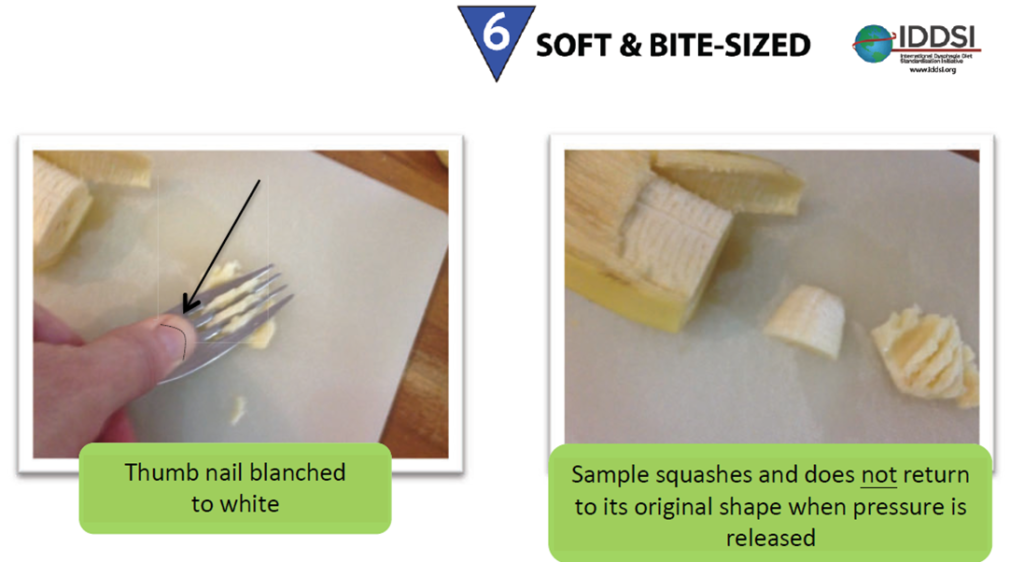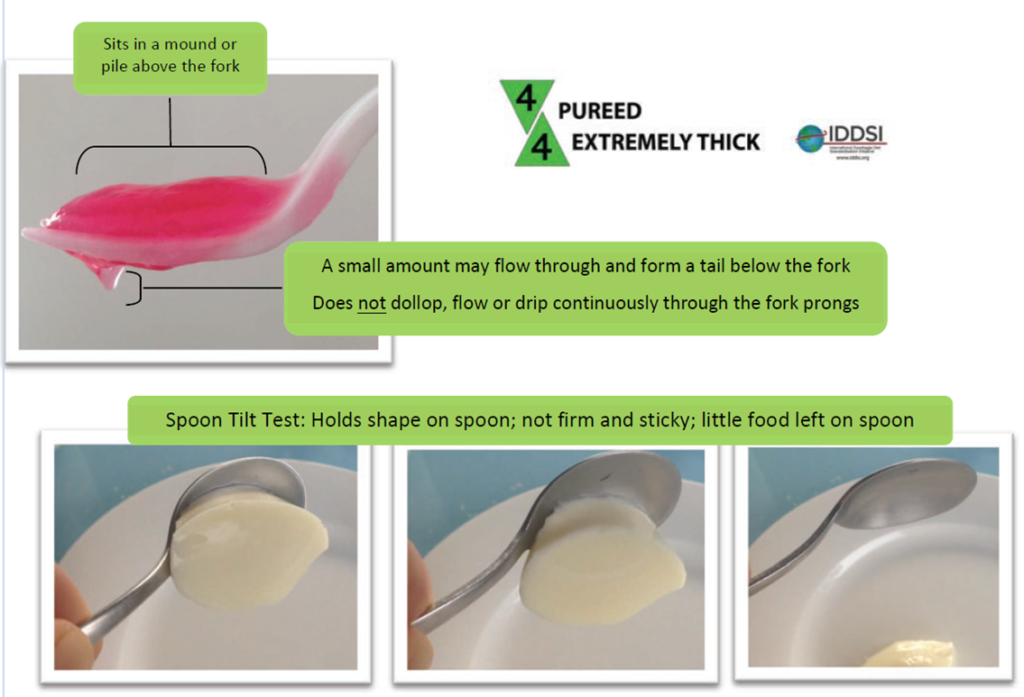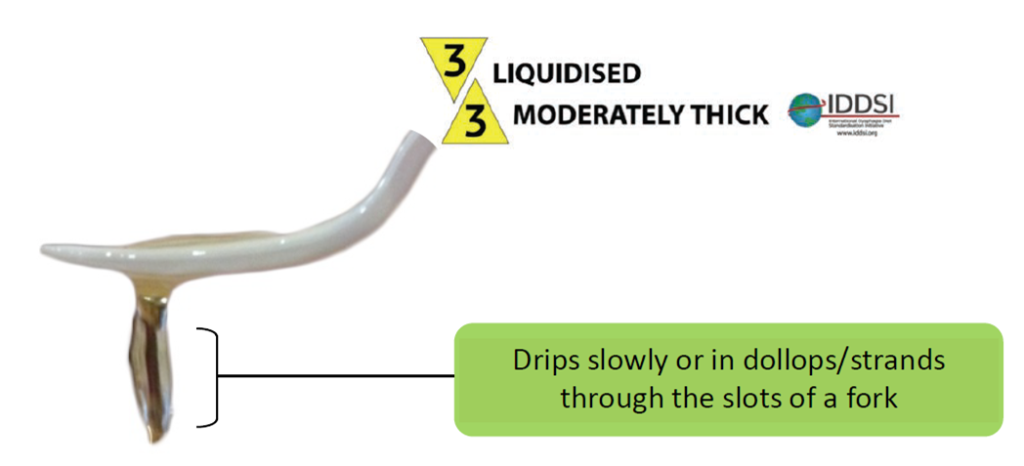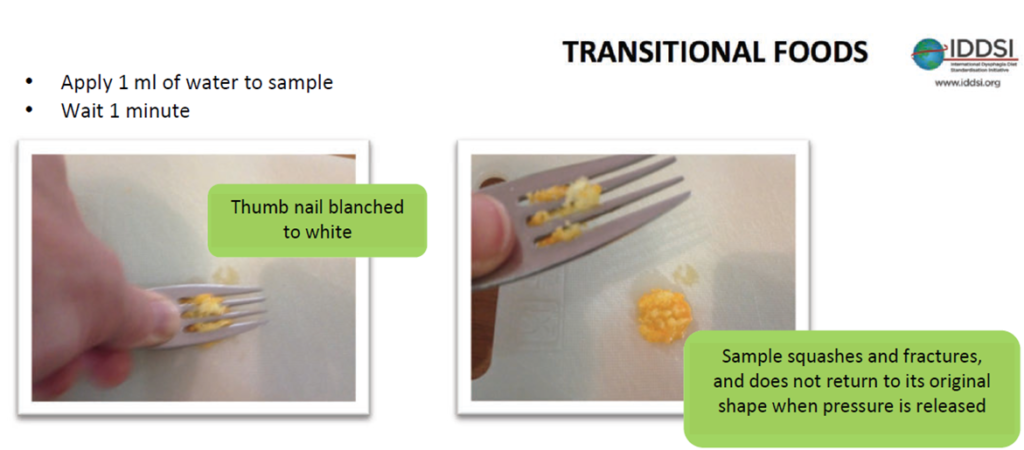IDDSI Diet Levels & Information
On this page:
7 – Regular
7* – Regular Easy Chew
6 – Soft and Bite Sized
5 – Minced and Moist
4 – Pureed
3 – Liquidised
Transitional Foods
Level 7 – Regular
What is a Regular diet? It is a diet which:
- Normal, everyday foods of various textures that are developmentally and age
- Any method may be used to eat the foods
- May be hard and crunchy or naturally soft
- Sample size not restricted
- Includes hard, tough, chewy, fibrous, stringy, dry, crispy, crunchy or crumbly bits
- Includes food that contains pips, seeds, pith inside skin, husks or bones
- Includes ‘dual consistency’ or ‘mixed consistency’ foods and liquids
Click here for printable IDDSI leaflet on mixed consistency foods
Level 7* – Regular Easy Chew
What is Easy chew food?
- Normal, everyday foods of soft/tender texture
- Any method may be used to eat these foods (e.g. fingers, fork, spoon, chopsticks etc.)
- Food piece size is not restricted in size. They can be smaller or bigger than 1.5cm x 1.5cm
- Do not use foods that are: hard, tough, chewy, fibrous, have stringy textures, pip/seeds, bones or gristle
- You should be able to ‘bite off’ pieces of soft and tender food, so they are safe to swallow without tiring easily
- You should be able to remove bone, gristle or other hard pieces that cannot be swallowed safely from your mouth without help or direction from others.
Click here for a printable IDDSI leaflet about easy chew
Click here for a printable IDDSI leaflet about easy chew (2)
Click here for a printable IDDSI leaflet about easy chew food examples
Click here for a printable IDDSI leaflet about easy chew foods to avoid
Level 6 – Soft and Bite-sized
What is a Soft & Bite-sized diet? It is a diet which:
- Can be eaten with a fork, spoon or chopsticks
- Can be mashed/brown down with pressure from fork/spoon/chopsticks
- A knife is not required to cut food, but may be used to help load fork/spoon
- Chewing is required before swallowing
- Is soft, tender, moist throughout
- Has no separate thin liquid
- Bite-sized pieces as appropriate for size and oral processing skills (Paediatric = 8mm pieces, Adults = 15mm pieces)
Testing Method:
If you are unsure whether your food is the correct consistency for a Soft and Bite-sized Diet, you can test it using the fork pressure test:
- Pressure from fork held on its side can be used to cut/break this texture
- Sample size (1.5×1.5cm) squashes and changes shape (not returning to its original shape) when pressure applied with base of fork (firm pressure – thumb nail blanches to white)

Click here for a printable IDDSI leaflet about soft & Bite-sized Diet
Level 5 – Minced and Moist
What is a Minced and Moist diet? It is a diet which:
- Can be eaten with a fork or spoon
- Can be scooped and shaped on a plate
- Soft and moist with no separate thin liquid
- Small lumps visible within food (Paediatric= 2mm lump size, Adult = 4mm lump size)
- Lumps are easy to squash with tongue
Testing Method:
If you are unsure whether your food is the correct consistency for a Minced & Moist Diet, you can test it using the Fork pressure test:
- Particles should easily be separated between and come through the prongs of a fork when pressed
- Particles can be easily mashed with little pressure from a fork
This consistency can also be tested using the fork drip test:
- The scooped sample sits in a pile or can mound on the fork
- It does not easily or completely flow or fall through the prongs of a fork

N.B. Lump sizes must be no bigger than:
- 2mm for children
- 4mm for adults
Click here for a printable IDDSI leaflet on minced and moist diet
Click here for an IDDSI YouTube Video demonstrating how to complete the fork-pressure-test.
Level 4 – Pureed
What is a Pureed diet? It is a diet which:
- Is usually eaten with a spoon (fork is possible)
- Does not require chewing
- Can be piped, layered or moulded
- Has no lumps
- Is not sticky
- Liquid must not separate from solid
Testing Method:
If you are unsure whether your food is the correct consistency for a Pureed Diet, you can test it using the spoon tilt test:
Take a spoonful of food and tip it off of the spoon. The food should be:
- cohesive enough to hold its shape on the spoon
- the full spoonful must plop off spoon if tilted/turned sideways (sliding off easily with very little left on the spoon)

Take a forkful of food. The food should:
- Sit in a mound or pile above the fork
- A small amount may flow through and fork a tail below the fork
- Does not dollop, flow or drip continuously through the fork prongs
Click here for a printable IDDSI leaflet on puree diet
Click here for an IDDSI YouTube Video demonstrating how to complete the spoon-tilt-test.
Level 3 – Liquidised
What is a liquidised diet? It is a diet which:
- Cannot be piped, layered or moulded on a plate
- Cannot be eaten with a fork because it drips slowly in dollops through the prongs
- Can be eaten with a spoon
- No oral processing/chewing required—can be swallowed directly
- Smooth texture with no ‘bits’ (lumps, fibres, bits of shell or skins, husk, particles of gristle or bone)
Testing Method:
If you are unsure whether your food is the correct consistency for a Liquidised Diet, you can test it using the fork drip test:
- Scoop up the food with a fork
- The food should drip slowly or in dollops/strands through the slots of the fork

Click here for a printable IDDSI leaflet on liquidised diet
Click here for an IDDSI YouTube Video demonstrating how to complete the fork-drip-test.
Transitional Foods
What are Transitional Foods? They are foods which:
- start as one texture (e.g. firm solid) and change into another texture specifically when moisture (e.g. water or saliva) is applied, or when a change in temperature occurs (e.g. heating)
Testing Method:
If you are unsure whether your food is a transitional food, you can test it using the fork pressure test:
- After moisture or temperature has been applied, the sample can be easily deformed and does not recover its shape when force is lifted

Click here for a printable IDDSI leaflet on Transitional foods
Click here for an IDDSI YouTube Video demonstrating how to complete the fork-pressure-test.


